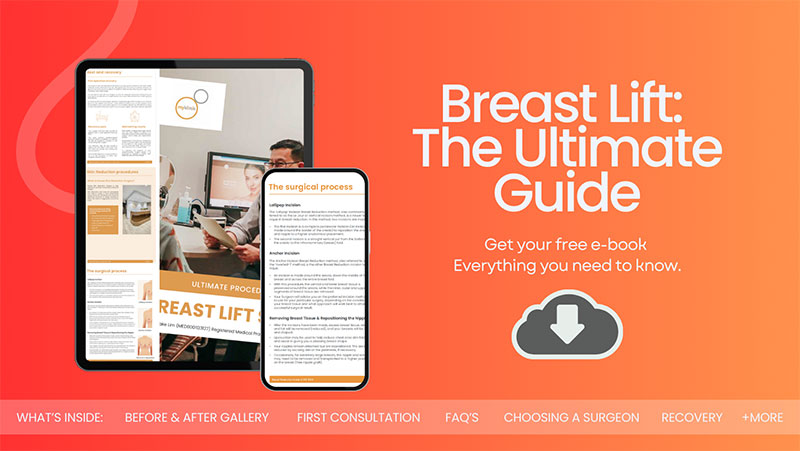How to Minimise Risks Associated with Breast lift (Mastopexy) Complications
Breast lift surgery, also known as mastopexy, is a procedure designed to raise and reshape sagging breasts, providing a more elevated contour. While many patients undergo this surgery without any issues, it’s important to understand that, as with any surgical procedure, there are potential risks and complications associated with breast lift (mastopexy).
In this blog, Sydney Specialist Plastic Surgeon Dr Jake Lim will discuss the common complications associated with breast lift (mastopexy) surgery, from immediate and aesthetic concerns to long-term challenges, and offers advice on minimising these risks.
Download Dr Lim’s Free 2024 Breast Lift Surgery Guide (Mastopexy)

Common Complications of Breast lift (Mastopexy) Surgery
Breast lift (mastopexy) surgery is a popular cosmetic procedure aimed at raising and reshaping sagging breasts to alter their appearance. Like any surgical intervention, breast lift (mastopexy) procedure comes with its set of potential complications. Understanding these risks is essential for anyone considering this surgery
Immediate Complications after Mastopexy
Haematoma
A haematoma is a collection of blood outside the blood vessels, typically in a clotted form, occurring within the tissue. In the context of breast lift (mastopexy) surgery, a haematoma can develop when blood vessels are damaged and bleed internally. The symptoms include swelling, pain, and a bruise-like discolouration. Haematomas can range from minor, requiring little to no intervention, to significant, necessitating surgical drainage to prevent infection or other complications. Prompt management involves applying pressure, cold packs in the initial stages, and possibly surgical intervention to drain the accumulated blood if the haematoma is large or growing.
Infection
Infection is a risk with any surgery. In breast lift (mastopexy) procedures, bacteria can enter through incisions, leading to an infection around the surgical site. Signs of an infection include redness, swelling, warmth at the incision site, fever, and discharge. Preventing infection starts with meticulous surgical technique, including sterilisation and the use of antibiotics before and sometimes after surgery. Treatment for an established infection involves oral or intravenous antibiotics. In severe cases, additional surgery may be required to remove infected tissue.
Anaesthesia-related Risks
General anaesthesia is commonly used during breast lift (mastopexy) surgery, carrying its own set of risks, such as allergic reactions, blood pressure fluctuations, and, in rare cases, more severe complications like anaesthesia awareness or postoperative cognitive dysfunction. The risk of anaesthesia-related complications is minimised by a thorough preoperative evaluation of the patient’s medical history and careful monitoring during and after the procedure.

Aesthetic Complications
Scarring
Scarring is an inevitable outcome of any surgery, including breast lift (mastopexy). The extent and visibility of scars depend on the surgical technique used, your skin type and your healing ability. Dr Lim tries to place incisions in less visible areas, such as around the areola or under the breast fold. Post-surgery, several strategies can help minimise scarring, including silicone sheets, scar massage, and, in some cases, laser treatments. It’s important to have realistic expectations regarding scarring and to follow Dr Lim’s aftercare instructions to ensure the best possible healing.
Changes in Nipple or Breast Sensation
Temporary or permanent changes in nipple or breast sensation can occur after a breast lift (mastopexy). Most patients experience temporary changes due to the repositioning of breast tissues and nerves during surgery. While sensation typically returns within a few months, some patients may experience permanent alterations in sensitivity. Discussing these potential changes with Dr Jake Lim before the procedure can help set realistic expectations.
Asymmetry
Perfect symmetry is an ideal, not a guarantee, in breast surgery. Post-surgical asymmetry can result from differences in healing, the natural variation in breast size and shape, or surgical technique. Minor asymmetries are common and often not noticeable. However, significant asymmetry may require revision surgery to correct.
Long-term Complications Associated with Mastopexy
Breastfeeding Difficulties
Breast lift (mastopexy) surgery can potentially impact breastfeeding capabilities. While some women can breastfeed after a mastopexy, the surgery may involve cutting through milk ducts, leading to reduced milk supply or, in rare cases, an inability to breastfeed. Discussing future pregnancy and breastfeeding plans with Dr Lim before undergoing a breast lift (mastopexy) is important.
Loss of Nipple and Areola
Although extremely rare, there is a risk of losing the nipple and areola due to compromised blood supply during surgery. This complication is more likely in extensive lift procedures or in patients who smoke, as smoking can impair blood flow. Dr Jake Lim takes great care to preserve blood supply to the nipple and areola, but you must be aware of this risk.
Need for Revision Surgery
Some patients may require revision surgery after a breast lift (mastopexy) to address complications or dissatisfaction with the initial results. Reasons for revision surgery include significant scarring, asymmetry, or changes in breast size or shape due to weight fluctuations or ageing. Discussing potential outcomes and the possibility of needing additional surgeries with Dr Lim beforehand can help manage expectations.

Minimising Risks and Complications
Minimising risks and complications is a critical aspect of any surgical procedure, especially in cosmetic surgeries such as breast lift (mastopexy). The journey towards a successful surgery with minimal complications involves several steps, starting well before the operation itself and continuing through to the post-operative care period. Here are some factors to consider if you want to minimise the risk of developing a complication after mastopexy surgery:
1. Choosing a Qualified and Experienced Surgeon
The importance of selecting a qualified and experienced surgeon cannot be overstated. A surgeon’s qualifications, experience, and track record are your first line of defence against potential complications.
Experience, particularly in breast lift (mastopexy) procedures, is crucial. An experienced surgeon is more adept at navigating the complexities of the surgery, anticipating potential complications, and making real-time decisions to mitigate risks. Furthermore, a skilled surgeon can provide a portfolio of before-and-after photos, allowing you to gauge their aesthetic judgment and the quality of their work.
When choosing a surgeon, don’t hesitate to ask about their experience with breast lift (mastopexy), their complication rates, and how they handle unexpected outcomes. This information will give you a clearer picture of what to expect and the confidence that you’re in capable hands.
2. Following Pre- and Post-operative Instructions Carefully
Adhering to Dr Lim’s pre- and post-operative instructions is important for a smooth recovery and the prevention of complications. Before the surgery, these instructions may include guidelines on smoking cessation, avoiding certain medications that can increase bleeding risk, and ensuring optimal health to withstand the stress of surgery.
Post-operative care is equally important. Following surgery, you’ll receive detailed instructions on how to care for your incisions, manage pain, recognise signs of infection, and when to resume normal activities. These guidelines are designed to promote healing, minimise scarring, and reduce the risk of complications such as infection or haematoma. Ignoring these instructions can lead to delayed healing, poor aesthetic outcomes, or more severe health issues.
3. Understanding the Importance of Realistic Expectations
Having realistic expectations is important for patient satisfaction and can indirectly minimise risks and complications. Unrealistic expectations can lead to disappointment, unnecessary stress, and even additional surgeries, which inherently come with their own set of risks.
A thorough consultation with your plastic surgeon should include a discussion about what the surgery can realistically achieve. Factors such as skin quality, age, and the natural anatomy of your breasts play a significant role in the outcome. Understanding these factors and having a clear, realistic vision of the results can help you make informed decisions about the surgery and prepare you mentally for the recovery process and the final outcome.
FAQs about Breast lift (Mastopexy) Complications

How common are breast lift (mastopexy) complications?
- Breast lift (mastopexy) complications are relatively uncommon, but like any surgical procedure, there are inherent risks. The majority of patients undergo breast lift (mastopexy) surgery without experiencing severe complications. Minor issues such as temporary changes in breast or nipple sensation, mild asymmetry, and scarring are more common but often resolve over time or can be treated effectively. Serious complications, such as significant infection or haematoma, occur in a small percentage of cases. The likelihood of experiencing complications can be greatly reduced by choosing a qualified and experienced surgeon and following all pre- and post-operative care instructions.
Can breast lift (mastopexy) go wrong?
- Yes, like any surgical procedure, a breast lift (mastopexy) can go wrong, although serious complications are rare when the surgery is performed by a qualified and experienced plastic surgeon. Potential issues can range from minor complications, such as unsatisfactory scarring or slight asymmetry, to more significant problems like infection, poor wound healing, or loss of nipple sensation. The risk of severe complications can be minimised through careful surgical planning, patient selection, and adherence to post-operative care instructions.
What if I am unhappy with my breast lift (mastopexy) results?
- If you are unhappy with your breast lift (mastopexy) results, the first step is to discuss your concerns with your plastic surgeon. It’s important to have realistic expectations from the start and understand that it may take several months for the final results to stabilise. If, after this period, you’re still dissatisfied, revision surgery may be an option. Revision procedures can address issues such as asymmetry, scar appearance, or further lifting. However, it’s crucial to weigh the benefits against the potential risks of additional surgery.
How complicated is a breast lift (mastopexy)?
- The complexity of a breast lift (mastopexy) can vary depending on the extent of sagging, the patient’s anatomy, and the desired outcome. Generally, it is considered a moderately complex cosmetic surgery. It involves removing excess skin, reshaping the breast tissue, and repositioning the nipple and areola to a more youthful height. The procedure requires precision and skill to achieve a natural-looking result while minimising scarring and preserving breast function. While it is more complex than some cosmetic procedures, with an experienced surgeon, most patients can expect good outcomes.
How long after breast lift (mastopexy) do breasts look normal?
- After a breast lift (mastopexy), the initial swelling and bruising usually subside within a few weeks, but it can take several months for the breasts to settle into their new shape and for the scars to begin to fade. Most patients can see the final results of their breast lift (mastopexy) approximately 6 to 12 months post-surgery. During this time, the breasts will gradually soften and the scars will lighten and become less noticeable.
Further Reading about Breast Lift (Mastopexy) with Sydney Plastic Surgeon Dr Jake Lim
- Read Dr Jake Lim’s Blog about Breast Reduction vs Breast lift (mastopexy)
- Read Dr Jake Lim’s Blog about Combining Breast lift (mastopexy) (Mastopexy) with Augmentation: Pros and Cons
- Read Dr Jake Lim’s Blog about What to Expect During a Breast lift (mastopexy) (Mastopexy) Consultation
- Read Dr Jake Lim’s Blog about Will Medicare Cover Breast lift (mastopexy) (Mastopexy)?
- Read Dr Jake Lim’s Blog about Exercise after Mastopexy (Breast lift (mastopexy)) – Tips and Timeline
- Read Dr Jake Lim’s Blog about Breast Lift Surgery – Myths and Facts
- Read Dr Jake Lim’s Blog about Breast Lift Techniques – Which One Is Right for You
Medical References about Breast Lift (Mastopexy) Complications
- Breast lift (mastopexy) Risks and Safety – American Society of Plastic Surgeons
- Mastopexy (Breast lift (mastopexy) Surgery): Does It Really Help? – WebMD
- Breast lift (mastopexy) with and without Implant
- Breast lift (mastopexy) – Australian Society of Plastic Surgeons
- Systematic review of outcomes and complications in nonimplant-based mastopexy surgery
About Dr Jake Lim
Highly qualified and experienced specialist plastic surgeon Dr Jake Lim focuses on facial plastic, cosmetic breast and body contouring after significant weight loss
Dr Lim creates the best possible plastic surgery results for his Australia-wide and international patients.
Dr Lim is passionate about making sure each and every patient has access to the right information about available treatments and procedures and is able to make well-informed decisions.
At My Klinik, patient safety, education and achieving optimal results are our top priorities.




